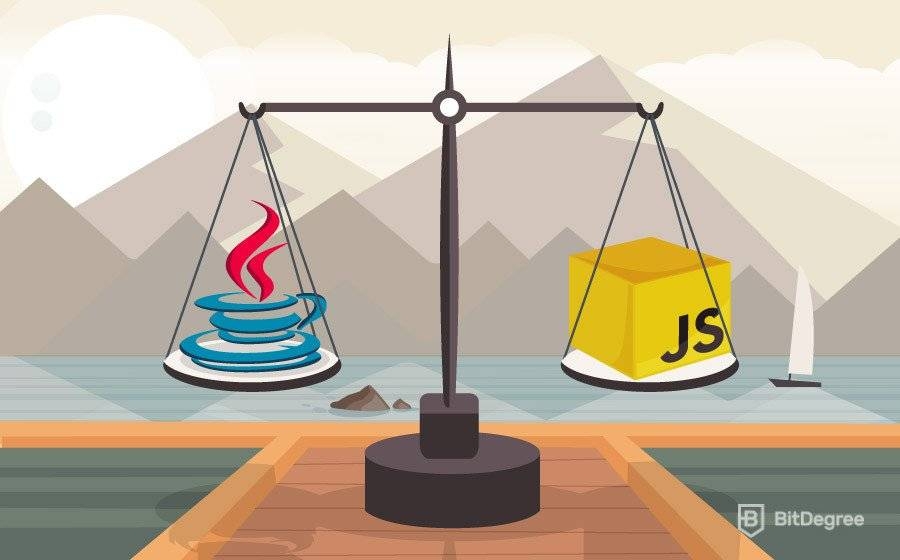Ace quick missions & earn crypto rewards while gaining real-world Web3 skills. Participate Now! 🔥
There is a famous saying that “Java is to JavaScript as ham is to a hamster”. This should give you some idea about how different these two programming languages really are, despite having similar names. We’ve prepared a comprehensive Java vs JavaScript comparison to help you understand which one is a better choice for the start of your coding journey.
Table of Contents
- 1. The origin stories: where it all began
- 2. Interpreted vs. compiled: what’s the difference?
- 3. Data types: checking explained
- 4. A few myths to bust
- 5. Class-based or prototype-based programming?
- 6. Java vs. JavaScript in terms of independency
- 7. Where and when to use both
- 8. The popularity contest
- 9. The final dots on the i’s
The origin stories: where it all began
The first difference between Java vs. JavaScript that most beginners learn is related to the time these languages have been around. Java has a slight edge here, as it actually came around first – but not by a wide margin.
Latest Deal Active Right Now:Take advantage of this special Udacity coupon code & access selected Udacity courses for free! Learn new skills & develop your career at zero cost.
The project for Java started in 1991 and was originally called Oak. However, this name was already registered for another company, so the creators replaced it with Java (as in coffee, consumed by them in great amounts) and released the first version in 1995. It got popular rather quickly, as it was based on C-style syntax which a lot of developers were already familiar with, plus, it promised the WORA (Write Once, Run Anywhere) principle.
In the same year, Netscape decided to write a new language that would attract more coding rookies instead of professionals. It was supposed to be a client-side language, running in the browser and not requiring any dedicated software. The developer named Brendan Eich wrote the prototype in ten days and called the project JavaScript.
Why such a similar name? Most believe the JavaScript team’s reason was purely promotional. While Netscape did have an intention to create something similar to Java at first, different purposes and goals caused significant distinctions.
Interpreted vs. compiled: what’s the difference?
When we discuss Java vs. JavaScript in terms of performance, the first thing we need to grasp is not the speed. There’s a difference in the very way they perform. Both Java and JavaScript are object-oriented. This means the developer has to deal with objects and their relations – say, inheritance. However, the main principle differs: Java is a compiled language, and JavaScript is an interpreted one.
As you write Java code in an Integrated Development Environment (also known as IDE), it gets compiled into bytecode. A human cannot read it, but a machine can, hence, a Java Virtual Machine (JVM) will be able to run it easily. The before-mentioned WORA principle actually relates to this as well: using a compiled language means making changes is basically rebuilding the program. Needless to say, this can be a complicated process and require using special software. Thankfully, Java code is compiled first and run later, so you can see the structural issues at once.
Now, JavaScript is a scripting language, which means it consists of a plain readable text. Therefore, the code gets executed in the same syntax you write it in, line by line. At some point in the past, this meant slower execution. Don’t worry – it’s not the case nowadays. However, you should keep in mind that this causes one more difference between Java and JavaScript: you can only detect bugs and issues when the program is running and not before that.
Having your script as a plain text also means you can apply changes easily by using any text editor, including the humble Notepad. This is crucial for JavaScript which, unlike Java, runs in the browser. Various browsers mean different environments and a bigger potential for errors to deal with.
Data types: checking explained
One more significant distinction that is very clear in comparing Java vs. JavaScript is the way each of them checks data types. Data type verification is a must in any program: most actions need specific data types to perform, and you need to make sure you are using the right ones. Using a type-safe program means avoiding the majority of type errors that could otherwise freeze it and disturb your daily work.
JavaScript chooses dynamic checking, found in most scripting languages. This means the safety of data types is verified dynamically as the program runs. This lets you use some powerful language features and simplifies using practices like metaprogramming. However, you will not be able to make sure the program is type-safe before running it, which will probably end in runtime errors.
Java, on the other hand, takes the road less traveled and uses static checking. This means the data types will be verified during compilation, and you will be able to catch most type errors earlier. If the compiler is aware of the data types you used, the code usually runs faster and eats up fewer resources.
A few myths to bust
You might think that static type checking is something that occurs in compiled languages, and dynamic checking works in interpreted ones. In most cases, it is indeed true, but here’s the thing: while a language can use static or dynamic type checking, a language implementation can be compiled or interpreted. This means that while Java is usually compiled, there could technically be an implementation that will be interpreted. However, it will still use static type checking.
One more common misconception is that static type checking must be used in a strongly-typed language. All calling a language strongly-typed means is that it has high type safety constraints: the variables are related to specific data types. However, the way the system checks the types has no effect on this. As we look into Java vs. JavaScript, we’ll see both are considered to be strongly-typed.
Class-based or prototype-based programming?
When comparing Java vs. JavaScript, you have to understand the basic difference in two programming types. Java is class-based, and treats inheritance and instantiation as two separate processes. JavaScript, on the other hand, is prototype-based, which means those same two feel like one. Confused? Let us simplify this for you.
In a class-based programming language (in our case, Java), you use a certain class to create objects. The class itself is not an object – think of it as a tool. For example, you do have to use a baking dish to make macaroni and cheese, but the dish itself cannot be your dinner. Now, in a prototype-based language (think JavaScript), you have a prototype instead of a class. It can be copied, or cloned, to make other objects, but, unlike class, it is an object in itself as well.
Java vs. JavaScript in terms of independency
Another big difference between Java and JavaScript is that Java is a completely independent programming language. This means it can be used alone on any operating system: all you need is a Java virtual machine. You can download and install it on your computer for free. Without it, you won’t be able to run Java on your computer.
JavaScript, on the other hand, is used in web browsers. Nowadays, it’s a real challenge to find a computer without one. However, this also means the performance of JavaScript relies strongly on HTML and CSS. Basically, HTML contains the structure of a web page, CSS lets you manipulate the styling, and JavaScript helps to create the functionalities. A non-functional structure is useless, and functionalities without any structure is, well… A hot mess.
Can you run Java in the browser? Yes and no. If you have used the world wide web for more than a few years, you might remember the time when you had to download and install a Java browser plugin to see any interactive or dynamic elements. Those were called Java applets and used somewhat widely. However, they are virtually extinct by now. As HTML5 provided a chance to embed media to your webpage directly, there was no need for potentially insecure third-party applets. Therefore, Java falls short among the browser users now.
Where and when to use both
We could go on and on explaining what is the difference between Java vs. JavaScript. However, we know that in the end, it all boils down to the goal set in your mind. While technically both Java and JavaScript can be used in front-end and back-end development, there are significant distinctions.
As a language of general purpose, Java has a slight edge here. It should be your first choice if you’re looking into creating enterprise software and applications for Android systems. It is rather popular in the financial and trading sectors, as well as big data and scientific applications. For example, systems for natural language processing are often written in Java. The WORA principle also makes it perfect for embedded systems, such as Java cards used in SIM cards.
Now, JavaScript was created for the web, and its main purpose is to help you create interactive, dynamic pages. It is still the best choice for your front-end needs. JavaScript is fine for e-commerce, user interface (UI) customization, and creating various simple tools.
We must note that you may expand the list of possibilities using various frameworks and libraries – both Java and JavaScript have ever-growing lists of those. This means you can use JavaScript for mobile and Java for web applications – and that’s not the limit to it.
The popularity contest
So who’s the winner in Java vs. JavaScript? Well, according to the Tiobe index, which represents the popularity of every programming language that exists, Java is actually more popular. In fact, it has been either the first or the second most popular language since it was created. However, JavaScript is also in the top 10.
What makes Java so popular? Well, first of all, it’s the fact the Java Virtual Machine is extremely cross-platform. The ability to use Java on each operating system and its portability is a huge plus to a developer. It is also backwards compatible, which eliminates the issues that may come with system updates. Last but not least, the long-lasting popularity of the language has also resulted in a huge user community, which simplifies learning it from scratch nowadays and offers massive support when issues arise.
A big user community is also what helps JavaScript grow its popularity: this language currently has the most pull requests on Github. Not only this language continues to be a top choice for front-end development, but it is also stepping strong into the back-end game with the Node.js framework. JavaScript is simple and fast, which makes it a great option for young companies.

Did you know?
Have you ever wondered which online learning platforms are the best for your career?
The final dots on the i’s
As you can see, there can be no clear winner in Java vs. JavaScript. Even though there are a lot of clear differences, both of these languages are popular and have their own user communities. The main reason for this is a clear distinction of the language purpose and projects you can develop using each.
We hope our comparison helped you understand what is the difference between Java and JavaScript, as well as make an informed decision. Of course, learning both to become a more skilled and flexible professional sounds like a perfect choice. Give that a thought, will you? And as you do, check out our courses on Java and JavaScript: they might be a great first step!












